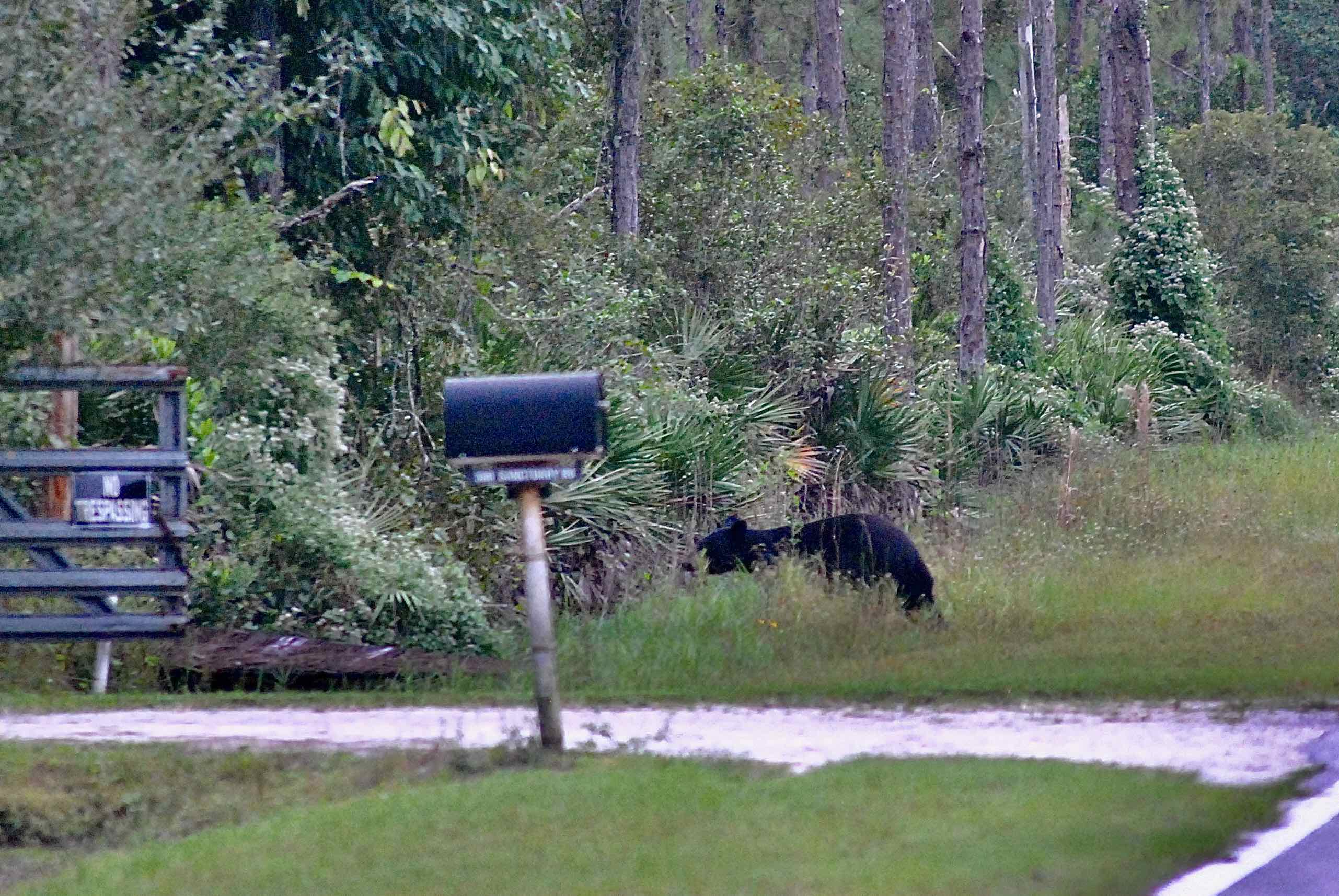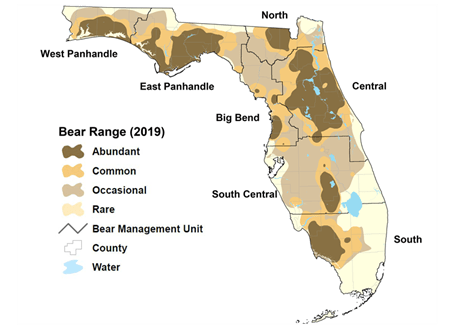
Florida black bear, photographed at Corkscrew Swamp Sanctuary, Naples, Collier County, in October 2013.
This is one creature, that despite its massive size, you rarely see, especially in the eastern part of the state. The Florida black bear, Ursus americanus var. floridanus, once numbered about 12,000 and roamed throughout most of Florida and parts of southern Alabama and Georgia.
According to a 2019 estimate, black bears now numbers about 4,050 (some estimates put the number much lower) and roam only a fraction of their former territory (about 45 percent, according to the Florida Fish and Wildlife Conservation Commission). The good news in those numbers is that about 50 years ago, the number of Florida bears was estimated to be only about 300. Florida declared the black bear to be "threatened" in 1974 and banned or limited hunting, allowing the species time to recover.
The FWC no longer lists the bear as threatened, but it still is illegal to kill or injure a bear, or possess bear parts. FWC did conduct what was supposed to be a weeklong hunting season in 2015 but shut it down after only two days. Hunters killed 304 bears during those two days, including some nursing mothers and undersized juveniles, according to reports. The FWC hasn't allowed a hunt since (as of this writing in January 2024), but hasn't ruled out future hunts either.
The human toll on the bear population that year was so severe — nearly 20 percent of the estimated total — that more than a dozen environmental and animal-rights organizations petitioned for the bear to be put on the federal endangered species list in 2016. The U.S. Fish and Wildlife Service, which oversees the list, declined the petition in 2017 after a 90-day study found that Florida's bear population sufficiently healthy.
But the biggest problem for the bear population, as it is for most large animals in Florida, is loss of habitat and habitat fragmentation.
It's estimated that a single bear needs 400,000 acres of land and a variety of different habitats, from scrub to swamp, in order to survive. Those 400,000 acres are becoming more and more scarce as Florida's human population expands. And as both bear and human numbers increase, the chances of conflict between the two also increase. One statistic that shows the conflict: collissions with cars and trucks are biggest cause of bear deaths. The FWC has divided the state into seven bear management units that correlate to current bear ranges as part of an effort to protect the creature — and its human neighbors. It conducts education programs aimed at limiting conflicts.
The FWC divides the state into a number of geographic areas to manage the bear population. The south management unit includes all of South Florida from the Atlantic to the Gulf. Its estimated population: 1,040 black bears, with most of the population concentrated in the western portion of the unit. The south is the second-largest management unit; the central unit, which includes Ocala National Forest, has the largest bear population at 1,200. Black bears occasionally will roam as far east as extreme western Palm Beach and Broward counties.
Some bear basics: The Florida black bear is one of 16 black bear subspecies found in North America, and the only one found in Florida. It looks pretty much like any other black bear found on the continent, but there are enough genetic and skeletal differences to give it status as a subspecies.
Generally, members of the same species will be larger the farther north you go, smaller, the farther south. It's called Bergmann's Rule, and is based on the idea that bigger body mass helps animals endure colder temperatures. We see that in Florida with white-tailed deer, which are substantially smaller in the Sunshine State than they are in points north. Florida's black bears, however, are about as large or even larger as their counterparts elsewhere in North America. They can be 5 or 6 feet long, 3 feet tall at the shoulder; an adult female can weigh between 150 to 300 pounds; a male between 250 and 400 pounds. The largest bears ever recorded in Florida weighed 740 and 760 pounds, respectively, and were found in Seminole County in 2015. The largest female weighed 400 pounds and was found dead in Liberty County.
Despite their large size and ponderous looks, they are fast and agile creatures. A running black bear can hit 35 mph, fast enough to smoke any human and fast enough to rival a race horse. They are excellent climbers.
The age of a bear can be determined by its teeth — because it hibernates, rings form in the enamel and just like trees, the number of rings correlate to age of the bear. The teeth have to be removed and sectioned, so it's not a practical method for gathering enough data to determinine the average lifespan of the bear, but a few things are known. The oldest male ever found in Florida was 20 years old; the oldest female was 22. Captive bears generally can live into their 30s; the oldest known bear of any species was a wild black bear female in Minnesota that died at 39. The only predators of an adult black bear: other bears and humans, which contributes to their longevity.
Although bears are omnivores, their diet is mostly vegetarian — fruits, nuts and berries, grasses and leaves — with a smattering of insects and a little meat thrown in. They will eat carrion. Bears, like the three individuals mentioned above, will reach abnormally large size when they have access to garbage and human food, which has a much higher calorie count than their normal diet.

FWC's bear management districts
Their weight can vary as much as 25 percent during the year. A bear typically takes in 5,000 calories a day; in the fall that number will increase to 20,000 a day, preparing for winter, when it will "den" and when food is less available. Come spring, it will resume its normal diet.
Bears are shy animals, most active at dawn and dusk depending on the season, although the FWC says bears that live on the fringe of human populations tend to be more nocturnal, when human activity is at a low point.
And despite Florida's mild winters, the black bear hibernates from December to April.
In summer, male bears spend most their time hunting for the ladies of the species, while the ladies themselves are spending their time foraging. Generally speaking, females become sexually mature between the ages of three and five years and will, uh, bear cubs every other year. They'll give birth to two to four cubs during the following winter, each weighing about a half pound. They'll remain with mom through the following winter, but will begin to disperse come spring at about 16 months. It's estimated that a quarter to half of black bear cubs die before reaching their first birthday.
Florida black bears are members of Ursidae, the bear family.
Corkscrew Swamp Sanctuary
